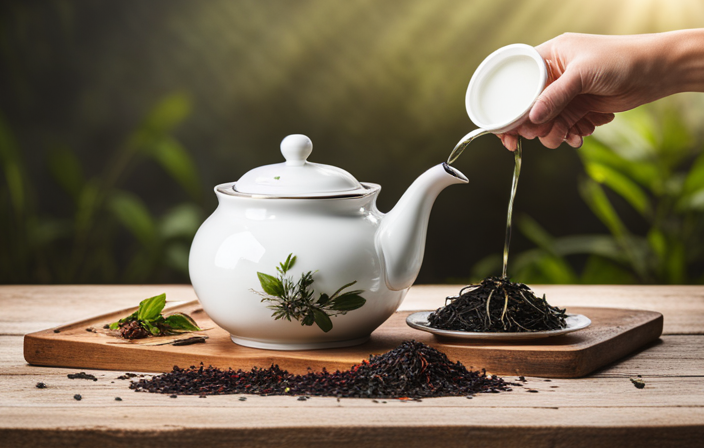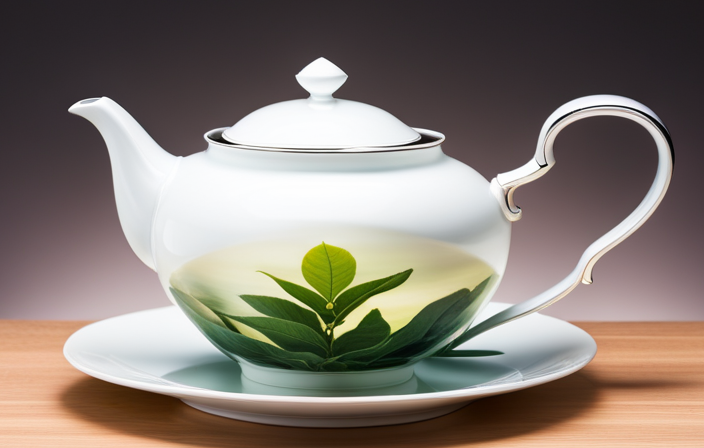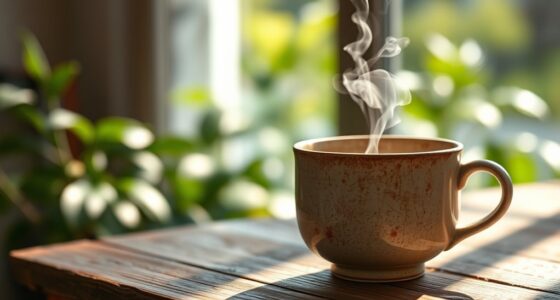As someone who enjoys a good cup of tea, I was shocked to discover that overconsumption can have negative health effects.
Did you know that drinking too much tea can lead to dehydration and increased heart rate?
It’s important to be aware of these potential risks, especially if you’re a tea enthusiast like myself.
In this article, we will explore the evidence-based health concerns associated with excessive tea consumption and how you can enjoy this beverage responsibly.
Key Takeaways
- Excessive tea consumption can lead to dehydration and increased heart rate.
- Caffeine overdose from tea can cause symptoms like increased heart rate, jitteriness, and anxiety.
- Drinking tea too often can increase the risk of teeth stains.
- Excessive tea intake may interfere with iron absorption and contribute to iron deficiency.
Excessive Caffeine Consumption
I’ve been feeling the effects of excessive caffeine consumption lately, and it’s starting to take a toll on my sleep.
Caffeine overdose can have adverse effects on our health, both physically and mentally. When consumed in excess, caffeine can lead to symptoms such as increased heart rate, jitteriness, and anxiety. It can disrupt our sleep patterns, making it harder to fall asleep and stay asleep throughout the night. This lack of quality sleep can then affect our overall well-being, leaving us feeling tired and groggy during the day.
Additionally, excessive caffeine intake can also lead to dehydration, as caffeine is a diuretic that increases urine production. It’s important to be mindful of our caffeine consumption and to find a balance that supports our health and well-being.
Risk of Teeth Stains
Drinking tea too often can increase the risk of teeth stains, but it’s a small price to pay for the delightful taste and numerous health benefits. While teeth discoloration may be a concern, it is important to consider the overall impact of tea on dental health. Tea contains compounds called polyphenols, which have been shown to possess antioxidant and anti-inflammatory properties. These properties can help to promote oral health and prevent the development of dental diseases. In fact, studies have suggested that tea consumption may reduce the risk of cavities and gum disease. To further illustrate the potential benefits of tea, here is a table highlighting some of the key dental health benefits associated with different types of tea:
| Tea Type | Dental Health Benefits |
|---|---|
| Green Tea | Reduces plaque formation, prevents cavities |
| Black Tea | Inhibits the growth of harmful bacteria, promotes gum health |
| Herbal Tea | Soothes inflamed gums, freshens breath |
While tea may contribute to teeth discoloration, its overall impact on dental health should not be overlooked. However, excessive tea consumption could potentially lead to another health concern – the possibility of iron deficiency.
Possibility of Iron Deficiency
I’ve been hearing a lot about the possibility of iron deficiency from drinking tea too often. Research suggests that excessive tea consumption, especially during meals, may interfere with iron absorption in the body.
This can increase the risk of anemia and other negative health effects associated with iron deficiency.
Let’s explore the points further to understand the potential impact of tea on iron levels.
Anemia Risk From Tea
Although I’m a regular tea drinker, I’m concerned about the potential risk of anemia from consuming excessive amounts of tea. While tea offers many health benefits, it’s important to be mindful of its potential negative effects.
Here are some key points to consider:
- Tea contains tannins, compounds that can inhibit iron absorption in the body.
- Anemia is a condition characterized by low levels of red blood cells, which can lead to fatigue and weakness.
- Iron is essential for the production of red blood cells, and tea’s interference with iron absorption could increase the risk of anemia.
- To mitigate this risk, it’s advisable to avoid consuming tea with meals, as it can hinder the absorption of dietary iron.
- It’s important to maintain a balanced diet rich in iron sources, such as lean meats, legumes, and leafy green vegetables, to support anemia prevention.
Decreased Iron Absorption
I have noticed that decreased iron absorption can be a potential consequence of excessive tea consumption. Iron is an essential mineral that plays a crucial role in carrying oxygen throughout the body. However, certain compounds found in tea, such as tannins, can inhibit iron absorption. This is particularly concerning for individuals who rely on plant-based sources of iron, as they already have lower bioavailability compared to animal-based sources.
Caffeine, a common component of tea, may also contribute to decreased iron absorption. Research suggests that caffeine can interfere with the body’s ability to absorb iron from food. This effect appears to be more pronounced when caffeine is consumed close to mealtime.
To ensure adequate iron absorption, it’s recommended to consume tea in moderation and separate its consumption from meals. Additionally, pairing tea with foods rich in vitamin C can enhance iron absorption, as vitamin C aids in the absorption of non-heme iron found in plant-based sources.
Overall, it’s important to be mindful of tea consumption and its potential impact on iron absorption, especially for individuals at risk of iron deficiency.
Pregnancy Concerns
Exercising regularly during pregnancy can help alleviate common pregnancy concerns. It’s important for expectant mothers to be aware of the potential risks associated with pregnancy and take steps to mitigate them. Here are some key considerations:
-
Maintaining a healthy weight: Regular exercise can help manage weight gain during pregnancy, reducing the risk of complications such as gestational diabetes and hypertension.
-
Improving mood and reducing stress: Exercise releases endorphins, which can improve mood and reduce stress levels during pregnancy.
-
Promoting better sleep: Regular physical activity can help regulate sleep patterns and improve the quality of sleep, which is often disrupted during pregnancy.
-
Increasing energy levels: Exercise boosts energy levels and reduces fatigue, making it easier to cope with the physical demands of pregnancy.
-
Preparing for labor: Regular exercise can help strengthen the muscles needed for labor and delivery, potentially making the process smoother.
In addition to exercise, it’s also important for pregnant women to be mindful of their caffeine intake. High levels of caffeine consumption have been linked to an increased risk of miscarriage and low birth weight. It’s advisable to limit caffeine intake to 200mg per day, which is roughly equivalent to one 12-ounce cup of coffee.
Transitioning to the subsequent section about impacts on sleep patterns, it’s crucial for pregnant women to prioritize their sleep hygiene and establish a regular sleep routine. Lack of sleep can worsen pregnancy symptoms and increase the risk of complications.
Impacts on Sleep Patterns
Drinking tea too often can have negative impacts on sleep patterns. Research suggests that tea contains caffeine, a stimulant that can interfere with the quality and duration of sleep.
Studies have shown that consuming caffeine close to bedtime can lead to difficulty falling asleep and increased risk of insomnia.
Sleep Disturbances From Tea
Having tea before bed can contribute to sleep disturbances, such as insomnia or interrupted sleep patterns. While tea is often seen as a soothing beverage, it’s important to consider its potential negative effects on sleep quality. Here are some key points to keep in mind:
-
Caffeine content: Tea, especially black and green tea, contains caffeine, a stimulant that can interfere with sleep. Even decaffeinated teas may still have trace amounts of caffeine.
-
Timing matters: Consuming tea too close to bedtime can make it harder to fall asleep. It’s recommended to avoid tea at least 3-4 hours before bed.
-
Individual sensitivity: Some individuals are more sensitive to caffeine than others, and even small amounts can disrupt their sleep.
-
Herbal alternatives: Opting for herbal teas that are naturally caffeine-free, such as chamomile or lavender, can be a better choice before bedtime.
-
Moderation is key: Enjoying tea in moderation throughout the day, rather than relying on it as a sleep aid, may help minimize sleep disturbances.
Insomnia Risk With Tea?
I didn’t realize the potential insomnia risk associated with drinking too much tea. As someone who values a good night’s sleep, this information has caught my attention.
While tea is often regarded as a soothing and calming beverage, it does contain caffeine, which can interfere with sleep. Caffeine is known to stimulate the central nervous system, making it harder to fall asleep and stay asleep. In addition to caffeine’s stimulating effects, its withdrawal symptoms can also contribute to insomnia.
When we consume tea regularly and then suddenly stop, the body may experience caffeine withdrawal, leading to restlessness and difficulty sleeping. To prevent insomnia caused by excessive tea consumption, it may be wise to limit tea intake, especially in the evening, and gradually reduce caffeine consumption to avoid withdrawal symptoms.
Digestive Issues
My stomach feels unsettled after eating spicy foods. It’s a common experience, and I know I’m not alone in feeling digestive discomfort and bloating. While spicy foods can certainly cause these issues, there are also other factors that can contribute to digestive problems.
Here are a few potential causes:
-
Overeating: Consuming large portions can put strain on the digestive system, leading to discomfort and bloating.
-
Food intolerances: Some people may have difficulty digesting certain foods, such as lactose or gluten, which can result in digestive issues.
-
Slow digestion: Slow digestion can lead to bloating and discomfort. Factors like stress, lack of physical activity, and certain medications can contribute to this.
-
Gas production: Certain foods, such as beans, lentils, and carbonated drinks, can produce excess gas in the digestive system, leading to bloating.
-
Gut bacteria imbalance: An imbalance in the gut microbiota can cause digestive issues. Factors like antibiotic use, a poor diet, and stress can disrupt the balance.
Understanding these potential causes can help us make informed choices about our diet and lifestyle to minimize digestive discomfort and bloating.
Dehydration
Drinking enough water is essential for preventing dehydration. Dehydration occurs when the body loses more fluids than it takes in, leading to a range of health impacts. It is important to recognize the risks associated with dehydration and prioritize proper hydration.
| Dehydration Risks | Health Impacts |
|---|---|
| Muscle cramps | Fatigue |
| Dizziness | Headaches |
| Dry mouth | Confusion |
Muscle cramps and dizziness are common symptoms of dehydration. When the body lacks sufficient fluid, it can lead to electrolyte imbalances, causing muscle cramps and feelings of lightheadedness. Additionally, dehydration can lead to fatigue, headaches, dry mouth, and confusion. These health impacts can significantly affect daily activities and overall well-being. To prevent dehydration and its associated risks, it is crucial to stay hydrated by drinking an adequate amount of water throughout the day. Remember, a well-hydrated body is essential for optimal health and functioning.
Increased Heart Rate
Sometimes, increased heart rate can be a sign of dehydration. It’s important to stay hydrated to maintain a healthy heart rate. In addition to dehydration, there are other factors that can cause an increased heart rate.
Here are some potential causes to consider:
-
Stress and anxiety: High levels of stress and anxiety can lead to an increased heart rate. It’s important to manage stress through relaxation techniques and self-care.
-
Physical exertion: Engaging in intense physical activity can temporarily raise your heart rate. This is a normal response to exercise and should return to normal after you rest.
-
Medications and stimulants: Certain medications and stimulants, such as caffeine and certain cold medicines, can cause an increased heart rate as a side effect. It’s important to be mindful of the substances you consume.
-
Thyroid issues: An overactive thyroid can cause an increased heart rate. If you suspect a thyroid problem, it’s important to consult with a healthcare professional for proper diagnosis and treatment.
-
Digestive issues: Digestive issues, such as acid reflux or gastroesophageal reflux disease (GERD), can sometimes cause an increased heart rate. It’s important to address any underlying digestive problems to alleviate symptoms.
Interference With Medication Effectiveness
I have noticed that taking certain medications while drinking tea can interfere with their effectiveness. Medication interactions can occur when the compounds in tea interact with the drugs we consume. This can lead to a decrease in drug efficacy and potentially compromise our health outcomes. It’s important to be aware of these interactions and consult with healthcare professionals to ensure the safe and effective use of medications.
Some studies have shown that compounds found in tea, such as polyphenols, can inhibit the absorption and metabolism of certain drugs, leading to reduced drug levels in the body. This can result in suboptimal therapeutic effects or even treatment failure. Therefore, it’s crucial to consider potential medication interactions when consuming tea and seek guidance from healthcare providers to optimize drug efficacy and ensure our well-being.
Frequently Asked Questions
Can Drinking Tea Too Often Lead to Weight Gain?
Drinking tea too often may potentially lead to weight gain due to its effects on metabolism.
As an avid tea drinker, I’ve noticed that certain types of tea can increase my appetite and make me crave more food.
Additionally, some teas contain caffeine, which can speed up metabolism and potentially lead to a higher calorie burn.
However, it’s important to note that individual responses to tea can vary, and moderation is key for weight management.
Is It Safe to Consume Herbal Teas in Large Quantities?
Drinking herbal teas in large quantities may not be safe due to potential risks associated with caffeine consumption.
As an avid tea drinker, I understand the desire to indulge in our favorite beverages. However, it’s important to be mindful of the potential negative health effects.
Consuming excessive amounts of herbal teas can lead to increased caffeine intake, which may cause sleep disturbances, heart palpitations, and even anxiety.
Moderation is key when it comes to enjoying our beloved teas.
Can Drinking Tea Too Often Cause Kidney Problems?
Drinking tea too often can potentially have negative effects on kidney health.
It’s important to note that while tea is generally considered a healthy beverage, excessive consumption can lead to an increased risk of kidney problems.
It’s advisable to moderate tea intake and consider alternative beverages to maintain overall kidney health.
Does the Temperature of Tea Affect Its Health Effects?
When it comes to the temperature of tea, it’s interesting to note that it can actually affect its health effects.
For example, studies have shown that the temperature of tea can impact its antioxidant levels. Higher temperatures may lead to a decrease in antioxidants, while lower temperatures can help preserve them.
Additionally, the temperature of tea can also affect its caffeine content. Hotter water tends to extract more caffeine from the tea leaves, resulting in a higher caffeine concentration.
Are There Any Specific Teas That Are More Harmful When Consumed in Excess?
When it comes to excessive tea consumption, there can be potential negative health effects. Some specific teas can be more harmful when consumed in excess.
It’s important to be mindful of the caffeine content in certain teas, as excessive intake can lead to issues like insomnia and increased heart rate.
Additionally, some teas may contain high levels of tannins, which can interfere with iron absorption in the body.
Moderation is key when enjoying tea to avoid these potential health risks.
Conclusion
In conclusion, while tea offers many health benefits, it’s important to be aware of the potential negative effects of excessive consumption.
Drinking tea too often can lead to issues such as caffeine overload, stained teeth, iron deficiency, disrupted sleep patterns, digestive problems, dehydration, increased heart rate, and interference with medication effectiveness.
It’s crucial to find a balance and enjoy tea in moderation to maintain optimal health and well-being.










